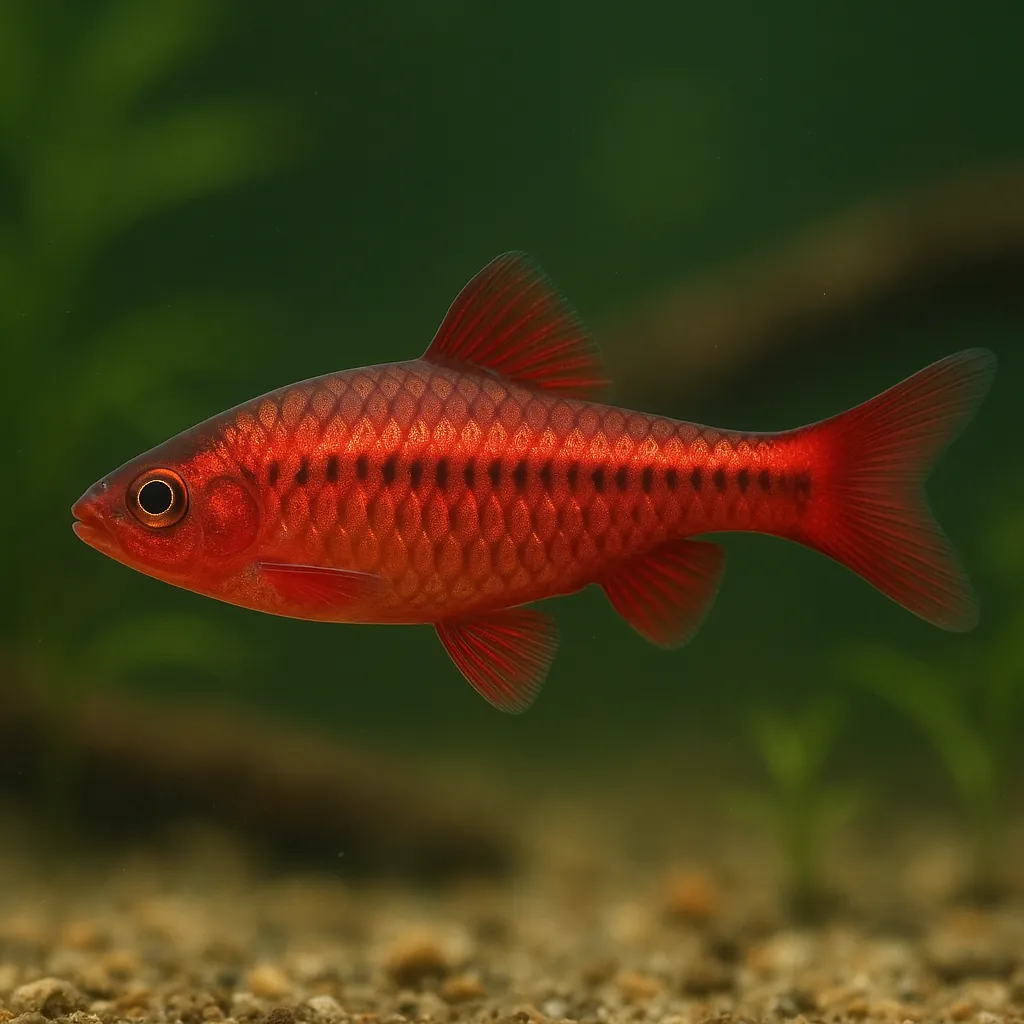
Cherry barb
Introduction
The Cherry Barb (Puntius titteya) is a vibrant and peaceful freshwater fish, cherished by aquarists for its striking red coloration and easy-going nature. Native to Sri Lanka, this species is well-suited for community tanks and is ideal for both novice and intermediate fishkeepers. With proper care, Cherry Barbs can thrive and add a splash of color to your aquarium.
Care and Environment
Providing optimal care for Cherry Barbs involves replicating their natural habitat and maintaining stable water conditions. Here's a comprehensive guide to ensure their well-being:
What is the minimum tank size for Cherry Barbs?
A minimum tank size of 20 liters is recommended for a single Cherry Barb. However, as they are schooling fish, it's best to keep them in groups of at least six, necessitating a larger tank.
What are the ideal water parameters for Cherry Barbs?
Cherry Barbs thrive in water temperatures between 23°C and 27°C, with a pH range of 6.0 to 7.0, and water hardness between 4 to 10 dGH. Maintaining these parameters is crucial for their health.
How should I set up the tank environment for Cherry Barbs?
Incorporate dense vegetation, such as Java Fern or Anubias, to provide hiding spots and mimic their natural habitat. A dark, sandy substrate enhances their coloration, and moderate lighting replicates the shaded streams they originate from. Ensure gentle water flow and use a reliable filtration system to maintain water quality.
What should I feed Cherry Barbs?
Cherry Barbs are omnivorous and should be fed a varied diet, including high-quality flake food, live or frozen brine shrimp, and daphnia. Offering a diverse diet ensures they receive all necessary nutrients.
Are there any specific challenges in keeping Cherry Barbs?
While generally hardy, Cherry Barbs can be sensitive to sudden changes in water parameters. Regular monitoring and gradual adjustments are essential. Additionally, males may display mild aggression during breeding, so providing ample space and hiding spots can mitigate potential conflicts.
Origin and Habitat
Cherry Barbs are endemic to Sri Lanka, inhabiting heavily shaded, shallow, and slow-moving streams and rivers. These waters are typically rich in vegetation, with silty substrates and abundant leaf litter, creating a serene environment that the Cherry Barb has adapted to over time.
What type of water bodies do Cherry Barbs naturally inhabit?
They are found in calm, slow-flowing streams and rivers with dense plant life and shaded areas, providing ample hiding spots and a stable environment.
How does their natural habitat influence their care in aquariums?
Replicating their natural habitat by providing dense vegetation, subdued lighting, and gentle water flow in the aquarium helps Cherry Barbs feel secure and exhibit natural behaviors.
Temperament and Compatibility
Cherry Barbs are known for their peaceful demeanor, making them excellent candidates for community tanks. They are schooling fish and thrive when kept in groups of six or more, which helps reduce stress and encourages natural behaviors.
Are Cherry Barbs aggressive?
Generally, they are peaceful, but males may exhibit mild aggression during breeding. Providing ample space and hiding spots can help minimize conflicts.
What are suitable tank mates for Cherry Barbs?
Compatible tank mates include other peaceful species like Neon Tetras, Corydoras Catfish, and Rasboras. It's advisable to avoid housing them with aggressive or fin-nipping species to maintain a harmonious environment.
How can I create a harmonious tank community with Cherry Barbs?
Ensure the tank is spacious enough to accommodate all inhabitants comfortably, provide plenty of hiding spots, and maintain stable water conditions to promote a stress-free environment for all species.
Interesting Facts
Cherry Barbs are not only beautiful but also possess intriguing traits that captivate aquarists:
- During breeding, male Cherry Barbs intensify their red coloration to attract females, showcasing a stunning display of vibrant hues.
- They are known to be more active during dawn and dusk, aligning with their natural crepuscular behavior.
- Cherry Barbs have been introduced to regions outside their native Sri Lanka, including Mexico and Colombia, where they have established populations.
Do Cherry Barbs have any unique behaviors?
Yes, they exhibit a fascinating "dancing" behavior during mating rituals, where males display vibrant colors and perform elaborate movements to court females.
How long do Cherry Barbs typically live?
With proper care, Cherry Barbs can live between 4 to 7 years, providing aquarists with years of enjoyment.
Sources
All information in this article has been gathered from the following reputable sources:
Overview
Recommended Tank Size 19.8 Gallons (for groups of 6 or more) |
Minimum Group Size 6 |
Minimum Tank Volume 5.3 Gallons |
Maximum Adult Length 2 inches |
Average Adult Length 1.6 inches |
Shoaling (6+ required) Yes |
Preferred Water Type Freshwater, soft, slightly acidic |
Temperature Range (°C) 23–27 |
pH Range 6.0–7.0 |
Water Hardness (dGH) 4–10 |
Typical Lifespan (years) 4 years |